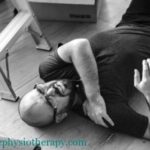Retrocalcaneal Bursitis is inflammation of the bursa located between the calcaneum and the anterior surface of the Achilles tendon. There are two bursae located just superior to the insertion of the Achilles tendon.
Retrocalcaneal bursa is located anterior to Achilles tendon. Posterior to the Achilles tendon lies a subcutaneous calcaneal bursa called the Achilles bursa. Inflammation of these bursae can cause pain at the posterior aspect of the heel and ankle.
This condition can often be mistaken for Achilles Tendinopathy or can also occur in conjunction with Achilles tendinopathy.
The insertion of the Achilles tendon, the bursa, and the bone are so closely related that the prominence of the calcaneum will greatly predispose to mechanical irritation of the bursa and the tendon.
It is quite common in athletes compared to normal individuals. In a normal population, the incidence is higher in individuals who are accustomed to wearing high-heeled shoes on a long-term basis.
Cause of Retrocalcaneal bursitis
- Overtraining in athletes
- Tight or poorly fitted shoes
- Haglund deformity
- Altered joint axis
Repetitive (cumulative) trauma or overuse can predispose the athletes and may be aggravated by wearing tight-fitting shoes.
It can also be associated with conditions such as rheumatoid arthritis, seronegative arthropathies, and gout.
In some cases, retrocalcaneal bursitis may be caused due to impingement of the bursa between the Achilles tendon and an excessively prominent posterosuperior part of the calcaneum (Haglund deformity). In Haglund disease, impingement occurs during ankle dorsiflexion.
Symptoms of Retrocalcaneal Bursitis
- Pain at the back of the heel, especially when running uphill.
- Pain may get worse when rising on the toes (standing on tiptoes)
- Tenderness at the back of the heel
- Swelling at the back of the heel.
Diagnosis:
A careful history taking, inspection/ observation of the region for bony prominence and local swelling as well as palpation of the area of maximal tenderness will help to clinically diagnose the condition.
Biomechanical faults, joint, and soft tissue stiffness can predisposition to retrocalcaneal bursitis.
A plain x-ray may reveal a Haglund deformity. However, in lateral x-ray in a weight-bearing position, the retrocalcaneal recess often appears normal, though the patient may have symptoms.
MRI could help to determine whether the inflammation is within the subcutaneous bursa, the subtendinous bursa, or even within the tendon itself; however, such testing is generally not necessary.
Ultrasonography is a useful tool for diagnosing pathologies of the Achilles tendon.
DIFFERENTIAL DIAGNOSIS :
- Posterior ankle impingement
- Haglund deformity
- Achilles tendonitis
- Partial rupture of Achilles tendon
- Plantar fasciitis
Treatment of Retrocalcaneal Bursitis
The initial treatment can be abbreviated as PRICE – protection, Rest, Ice, Compression, and Elevation. The patient may have a painful limp, so the Achilles tendon needs to be rested from complete weight-bearing activities. The patient may need to be on partial-weight-bearing. Avoid shoes and sandals with straps that can irritate the retrocalcaneal bursa. Ice can be applied to reduce pain and swelling. Apply for 10-15 minutes every 3 to 4 hours during the initial inflammatory phase.
Anti-inflammatory medication and salicylic acid-containing ointments may help reduce pain. Apart from these, physiotherapists may use several useful modalities and techniques to reduce pain and swelling. Gradual progressive stretching of the Achilles tendon helps in relieving the subtendinous bursa impingement. It is done by the Physiotherapist and should be repeated several times a day by the patient as well. Guidelines of a self stretch of Achilles tendon is mentioned below –
- While Stand in front of a wall, with non-affected foot ahead about a step distance. Lean forward toward the wall, bending the front knee at the same time, until a gentle stretching is felt within the calf muscle of the affected leg.
- Important points to consider while doing this self-stretch,
- The heel of the affected leg should not rise,
- Toes of the affected leg should face straight ahead,
- The stretch should be performed in knee bend and knee straight position to stretch different muscles of the calf.
- Maintain the stretch for 15-20 seconds and then relax. Repeat 5 times in one go.
- Repeat the above steps several times a day.
Surgery:
If conservative treatment fails, which is not often the case, surgical treatment can be undergone. Surgical debridement of the inflamed tissue and repair of Achilles tendinopathy is seen while performing the surgery arthroscopically.





